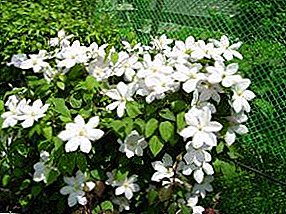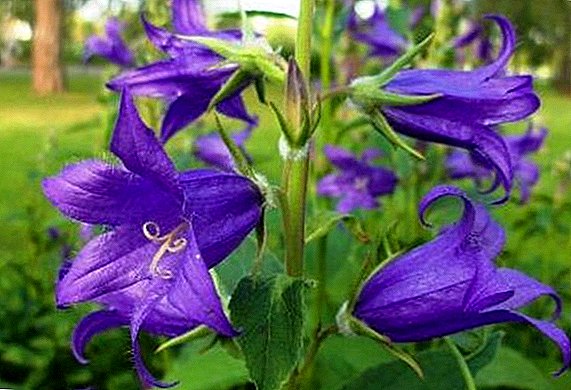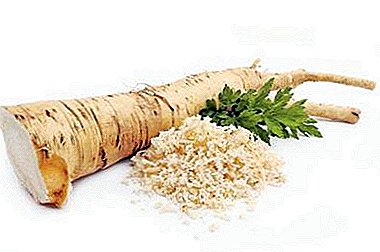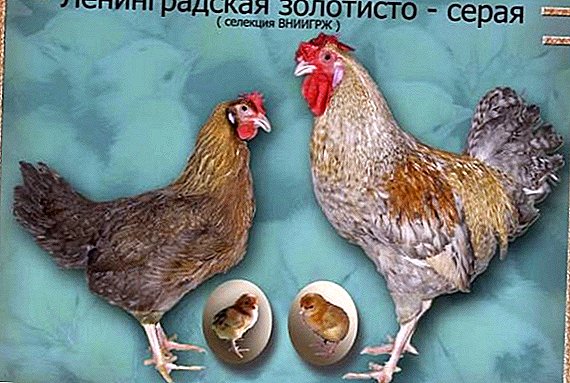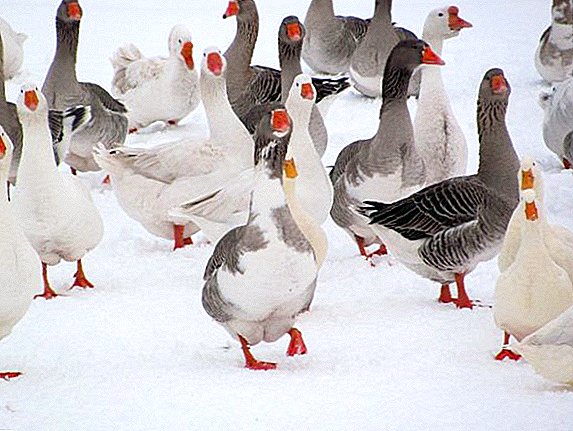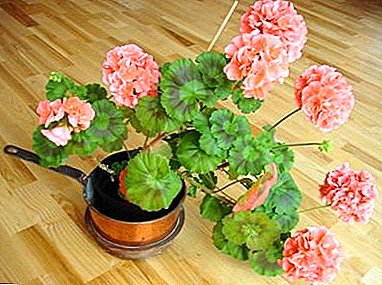
Room geranium is one of the most common flowers of modern times. To care for the plant is not difficult, it multiplies in various ways. And the varieties and types of geraniums are numerous.
A flower can be annual and perennial. Stems reach 50 cm in height. The leaves of the flower are bright, dark green. Flowers most often large or are collected in inflorescences. In this article, you will read everything about this plant, learn when it blooms, what types and varieties are, what are the features of growing a flower.
Botanical description and history
The plant belongs to the genus of semi-shrubs and herbaceous. Included in the family of geranium.
 About 400 geranium species are known at this time.that grow all over the world, including in tropical countries. If you translate the word "geranium" from the Greek language, it will mean "crane". This is due to the shape of the fruit of the plant, which is remotely similar to the crane's beak.
About 400 geranium species are known at this time.that grow all over the world, including in tropical countries. If you translate the word "geranium" from the Greek language, it will mean "crane". This is due to the shape of the fruit of the plant, which is remotely similar to the crane's beak.
The flower was introduced to Europe from the African continent as early as the 17th century. Particularly liked the bright and magnificent plant of the European aristocracy. Subsequently, geranium spread to other classes. This plant was brought to Russia only in the 18th century.
What is this flower and its difference from garden
The difference between these geraniums is, for example, in flowering. Home flower has a more lush and varied floweringrather than garden geraniums.
Indoor geranium, unlike garden geranium, hardly adapts to cold weather, therefore it is very important to warm the flower during the winter period. For the summer, the flower can be brought out and even transplanted into a flower bed, but with the onset of cold weather the plant is transferred to the room.
Popular species and varieties: their name and photo
There are many varieties of room geraniums, consider how the plants look in the photo and give a brief description of each name.
Undersized
It is also called dwarf, or sprayfor small size. The stem grows to 60 cm. The inflorescences are located on the tops of the shoots in the form of umbrellas.
This variety blooms profusely from early spring to midwinter. The color of the flowers is different: yellow, red, pink, white, etc.

Therapeutic
It is not as beautiful as other ornamental varieties of this plant. And the purpose of growing medicinal geraniums is different. Therefore, the main focus is on increasing the green mass of the shrub.

Blue
The flower pleases with its bluish tinge. The most popular varieties of this species are "Johnson's Blue" and "Himalayan."
On a photo a grade of a geranium "Johnson's Blue":
Below is the Himalayan geranium:

Zonal
This species blooms with lush flowers and is most popular with gardeners. Almost all varieties of this species have a main stem, from which the refrain foliage departs. The leaves themselves have a small down on their surface and thin a peculiar smell.
Subspecies are divided by leaf part. So, they are terry, semi-double and normal. The shape of the flowers are divided as follows:
- Tulip. In the form of closed tulips.
- Rosebuds, geranium flowers resemble the buds of undiscovered roses.
- Cactus, their petals twisted, like chrysanthemums.
- Stellar, in form resembling a star.

Fragrant
The fragrant geranium spreads a pleasant peculiar smell throughout the room. This species was popular in the last century, when not beautiful flowers were valued, but the attractive aroma of plants. They played the role of deodorizing the room. And today, this kind of hybrids and varieties are popular.

Fragrant geranium does not stand out for its beautiful flowering or attractive appearance. Many people grow it just for flavoring rooms and as an additive to dishes. Some housewives put the leaves of this flower in the wardrobes with clothes, bed linen, etc.
Reference. From the leaves of fragrant scents emanate fruits, roses, mint, pine needles and carrots.
Royal
The royal variety was bred by breeders in an inter-specific hybridization process. The flowers of the plant are large, in volume reach 7 cm. But not only the sizes of semi-double rims distinguish royal geranium from other varieties.

Its feature is also the variety of color coloring. Its petals have contrasting spots, which appear as specks or streaks.
Reference. Royal geranium is capricious in the care. It blooms much less than other geraniums - about 4 months. It will be possible to admire flowers only 2 years after planting.
Where and how to plant?
- For the flower is not required too fertile land. Otherwise, the plant will give many leaves and few flowers.
- A container designed for geraniums must have a sufficient number of openings so that air can freely circulate there and there is an outflow of excess moisture.
- A drainage layer is laid at the bottom. It consists of expanded clay, pebbles and foam.
- Watering is carried out as the soil dries. In winter, it is generally required only two times per month.
- The pot is installed on the illuminated window sill, otherwise from a lack of light the plant will quickly die or stretch out and acquire an ugly shape. Therefore, usually the pot with the plant is placed exactly on the south side. Only in too hot days may be needed shading.
Lighting and location
If there is enough light, then the geranium blooms will be abundant. You need to choose the south side to install the pot. Only in this case the plant will bloom for a long time.
Soil requirements
 As mentioned above, too fertile soil for the flower is not taken, as there will be a lot of foliage and few flowers.
As mentioned above, too fertile soil for the flower is not taken, as there will be a lot of foliage and few flowers.- Be sure to drain before planting.
- Fertilizers are applied throughout the growing season. In particular, the desired result gives a liquid fertilizer.
For feeding you can use the solution with the addition of iodine. For this, a drop of iodine is dissolved in one liter of water. After which you should water the plant. But it is necessary to ensure that the solution does not get to the roots, so watering is carried out on the walls of the pot. Experienced gardeners say that after such dressing the flower blooms well.
How to provide the right care?
When caring for room geraniums, the following rules should be followed:
- It is impossible to flood the geranium, as the plant tolerates an excess of moisture much worse than drought. Indoor geranium is not sprayed with water. Drops of moisture, falling on the leaves, get stuck between their villi, and creates a favorable environment for the reproduction of bacteria.
- No need to worry about the flower in the hot season, the plant easily tolerates high temperatures.
- If the lighting is not enough, then artificial fluorescent lamps should be used, so the buds will be formed more actively.
- Dried soil is regularly loosened to ensure the flow of moisture and oxygen to the root system. You can use the old fork or wooden stick.
Common diseases and pests
 It is also necessary to inspect the plant for the presence of pests. If aphids or mites are detected, it is necessary to treat the lower part of the flower with tobacco mixed with a solution of soap.
It is also necessary to inspect the plant for the presence of pests. If aphids or mites are detected, it is necessary to treat the lower part of the flower with tobacco mixed with a solution of soap.
After a few hours, rinse with warm water. But the whitefly so easy not to destroy, just need to use insecticides, like "Confidor".
Of the most common diseases of geraniums, the most common are fungus or virus.
For fungal diseases include:
- blackleg;
- rot;
- leaf rust.
Treat them with various solutions, which include fungicides. Sometimes you can see that the leaves began to turn yellow in the flower, then they dry up and fall off.
Often the reason lies in the wrong care, namely:
- if the foliage edges turn yellow, this indicates a lack of water;
- on the contrary, the falling off and withering of the leaves speaks of the gulf of geranium;
- the fall of the lower part of the foliage signals a lack of light.
Another frequently asked question: why does geranium not bloom?
The answer may lie in improper feeding of the flower. If the added fertilizer contains a lot of nitrogen, then the green base of the plant is well formed, while flowering is scarce or absent altogether.
Breeding features
 Geranium propagates in two main ways:
Geranium propagates in two main ways:
- Seminal.
The negative point of this method of reproduction is that future plants will not always repeat the maternal properties of the hybrid.
- Cuttings.
This method can be used all year round.
Seeds
- Seeds are sown in specially prepared soil. For this, peat, sand, and the double size of sod land are taken in equal parts.
- The bottom of the dish is drained.
- Seeds are placed at a distance of 2 cm from each other, sprinkled with earth on top and watered with a spray gun.
- After that, you need to cover the seeds with film or dishes and create a temperature of +20 degrees. Daily shelter is removed, and the soil is ventilated.
- As soon as the seeds germinate, the shelter is removed altogether and the air temperature drops.
Cuttings
This is done all year round, but precisely spring roots on cuttings form faster.
- After cutting off the cutting, it is left for 2 hours in the air, so that the place of cutting will dry.
- Planting is carried out in a container with loose soil or coarse sand.
- Cover it is not necessary.
After rooting the cutting, it can be transplanted into another container.
Many gardeners are advised to start planting plants with geraniums. They are unpretentious and will always delight long and abundant flowering with proper care.


 As mentioned above, too fertile soil for the flower is not taken, as there will be a lot of foliage and few flowers.
As mentioned above, too fertile soil for the flower is not taken, as there will be a lot of foliage and few flowers.
